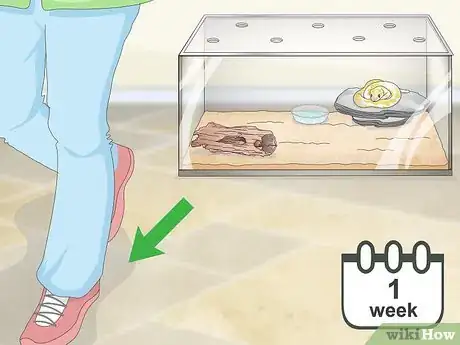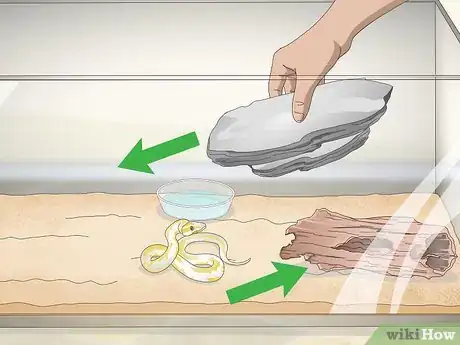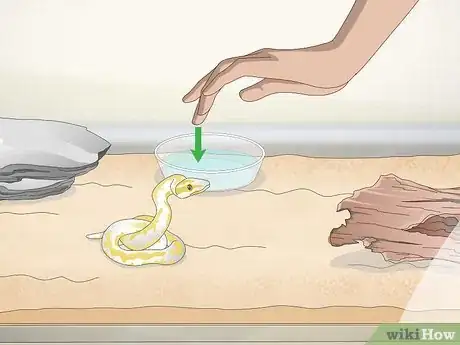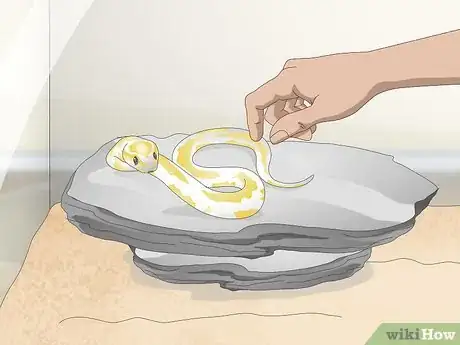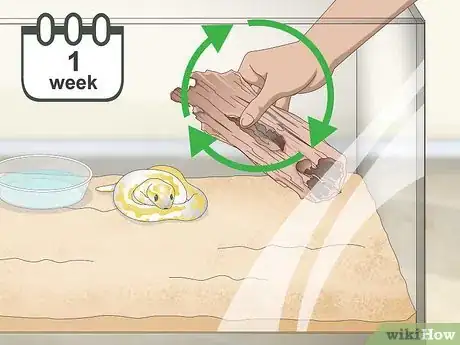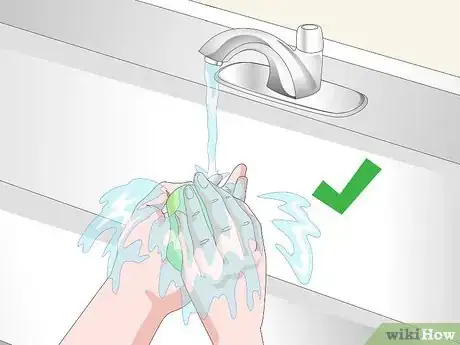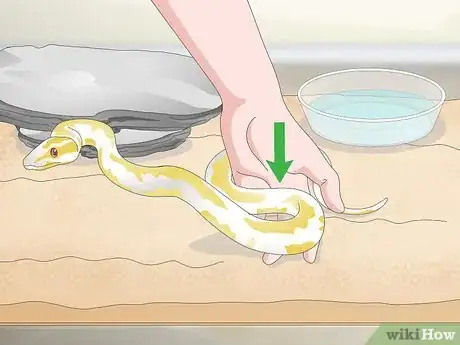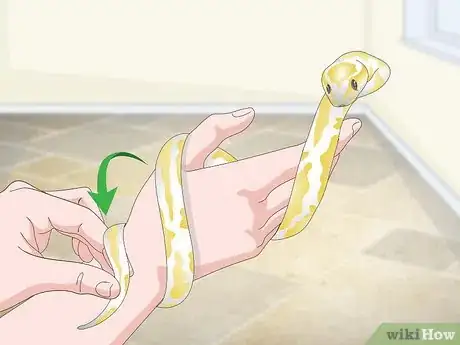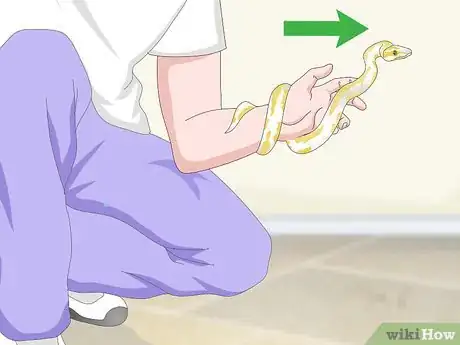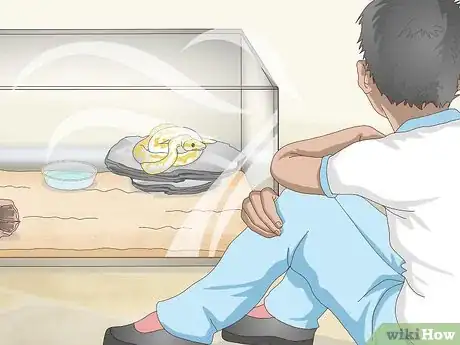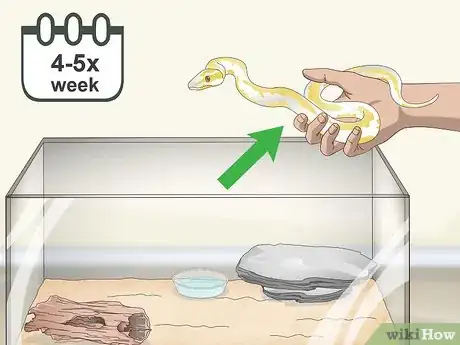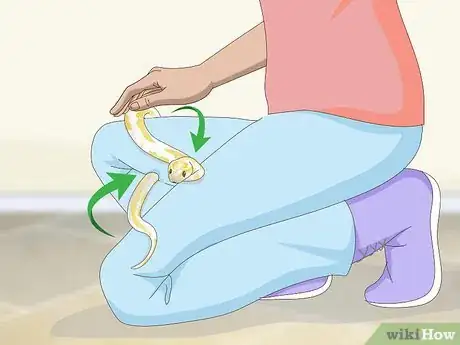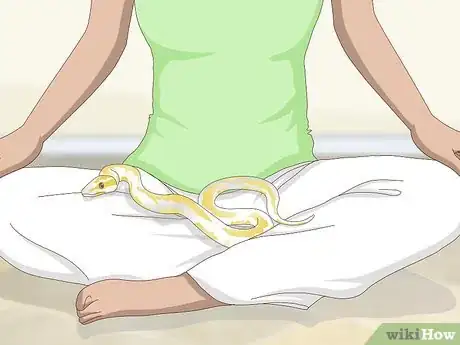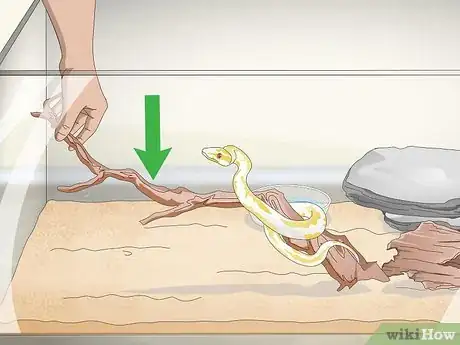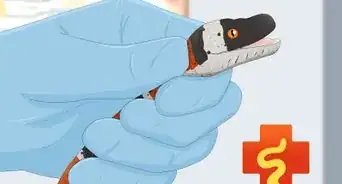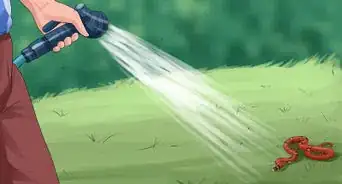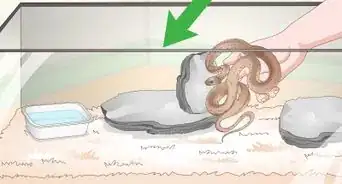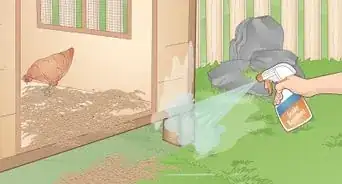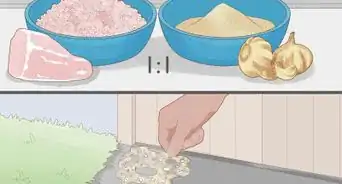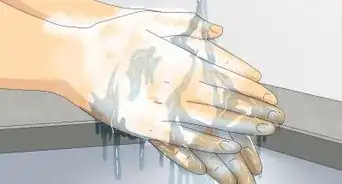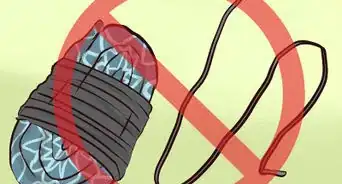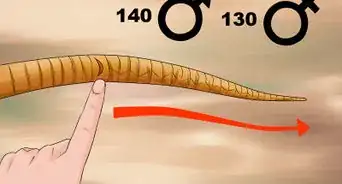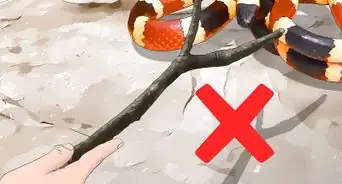This article was co-authored by Jeff Jensen and by wikiHow staff writer, Hunter Rising. Jeff Jensen is a Reptile Specialist and the Owner of The Reptile Zone out of Bend, Oregon. With decades of experience with reptiles and wildlife, Jeff specializes in providing advice and guidance on proper reptile care. As a former science teacher and employee of the San Antonio Zoo and an accomplished herpetologist, Jeff’s dedication to knowledge and ethical pet trade practices led to The Reptile Zone being awarded a “Mark of Excellence” Award by Intrepid Marketing in 2018.
This article has been viewed 91,407 times.
Pet snakes make great low maintenance pets, but they don’t bond with their owner the same way a dog or cat would. If you want to make your snake comfortable with you, then all you need to do is let it be familiar with your presence and handle it often. The more time you spend with your snake, the more it will relax and enjoy being held!
Steps
Letting Your Snake Get Used to You
-
1Leave your snake alone for the first week you have it. When snakes are first introduced into a new home, it takes them some time to acclimate to their environment. Leave the snake in its tank while it takes the time to adjust. After a week, you can start interacting with your snake.
- If you’ve waited a week and your snake is still acting aggressive, wait for 3-4 more days before trying again.
-
2Rearrange your snake’s tank occasionally so it gets used to your presence. Move its water dish, home, and any branches around the tank so your snake gets comfortable with you in its environment. Be careful not to touch your snake while you’re moving things. Use slow and deliberate movements so you don’t scare your snake. This will help it learn that you aren’t going to cause any harm.
- If your snake makes an S-shape with its neck while it’s looking at you, it may be getting into striking position. Pull your hand out slowly so your snake doesn’t try to bite you.
Advertisement -
3Hold your hand in front of your snake’s head so it gets used to you. Snakes recognize things by smell, so your snake needs to get comfortable around your scent. Try holding your hand about 3–4 in (7.6–10.2 cm) away from your snake’s head so it can smell you. If it gets into striking position, slowly move your hand out of the way. If your snake doesn’t react, try moving your hand closer.
- If you’re worried about bites and your snake is aggressive, consider wearing thick gloves as a layer of extra protection.
-
4Touch your snake while it’s still inside the tank. Once your snake is acclimated to its new environment, try lightly touching the back of its body near the tail. Put your hand in from the side rather than directly over the snake so it’s more comfortable. Slowly work closer to touching close behind its head.
- Avoid trying to touch the snake’s head right away since it might get scared and bite.
- Never try to grab your snake by its tail since it will most likely try to spin around and strike you.
Warning: Wash your hands after you touch your snake since it may carry salmonella.
-
5Continue familiarizing yourself with your snake for 1 week. Rearrange the tank once per day, and hold your hand in front of your snake 3-4 times at different times. Over a week’s time, your snake will get used to your presence and is less likely to strike or bite you when you try to handle it.[1]
- If your snake is still acting aggressive, don’t try to handle it until it gets calmer.
Handling Your Snake
-
1Wash your hands before handling your snake. Thoroughly wash your hands right before you reach into the tank. That way, you don’t spread any germs to your snake when you’re about to hold it.[2]
-
2Scoop your snake up by the middle of its body. Slide your hand underneath your snake’s body halfway between its head and tail.[3] Squeeze your snake lightly until you have a firm grip around its body. Slowly and confidently pick the snake up and out of its enclosure, using your other hand to support the rest of its body.
- Don’t try to act nervous or timid while you pick up your snake because it will be able to sense your body language. Instead, stay consistent and firm so your snake gets used to being handled.
Tip: If you feed your snake in its enclosure, it may associate you trying to pick it up with feeding time and try to strike your hand. If this happens, start moving your snake into a different tank before you feed it.
-
3Intertwine the back third of your snake around your arm or fingers. While supporting the middle of the snake’s body with one hand, let the back end rest on top of your arm and in your hand. Wrap larger snakes around your arm and smaller snakes in between your fingers so it doesn’t flail around while you’re holding them.[4]
- If you have a constrictor snake, such as a ball python or a boa, let it wrap around your arm so it feels comfortable.
- If you have a thinner snake, like a garter or corn snake, keep the back of the snake wrapped between your fingers so it's less likely to slither away.
- If your snake is larger than 4 ft (1.2 m) long, have another person help hold it for every additional 3 ft (0.91 m).
-
4Point the snake’s head away from your body. Snakes may try to strike anything that moves quickly in front of their heads, so avoid keeping your snake pointed towards your body when you first start handling it. Guide the snake’s head in the opposite direction by pushing on its neck with your arm. Use slow and confident movements so your snake gets used to the behavior.[5]
- As your snake gets more comfortable around you, it’s okay to let your snake look in your direction. Just make sure to watch for any striking behavior.
Spending Time with Your Snake
-
1Sit near your snake’s tank often so it can get used to your scent. When you aren’t handling your snake, try to spend time in front of its tank so it stays familiar with your scent. This will help your snake grow accustomed to you so it will know not to strike while you’re around.
- The more familiar you are with your snake, the less aggressive it will be over time. Make sure to spend at least a few minutes near your tank each day.
-
2Take your snake out of its tank 4-5 times a week. Try to handle your snake as much as you can so it gets used to being around you. Aim to hold your snake for at least 20-30 minutes each day so it has a chance to spend time with you.
- Avoid handling your snake 2-3 days after you feed it since it will need time to digest.
-
3Let your snake slither around the area near you when you hold it. When you hold your snake, set it on your lap so it has a chance to slither around you.[6] Make sure to keep it supervised so it doesn’t slither away from you or get lost in your home.
- This works best for large snakes like pythons and boas. Smaller snakes move faster and may get away easier.
-
4Keep your snake on your lap while you’re relaxing. While you’re playing video games, watching TV, or reading a book, keep your snake on your lap so it can spend time with you. Make sure not to make any sudden or fast movements and stay quiet so your snake doesn’t get scared.[7]
- Keep your snake out of its tank for only about 30 minutes at a time so it doesn’t lose any body heat.
-
5Give your snake new branches and objects to climb in its tank. Change the environment inside of your snake’s tank so it has new places to explore and hide. After you’ve finished adding the new enrichment to your tank, put your snake back inside and let it slither around while you watch.[8]
Community Q&A
-
QuestionWould I be able to leave my scent on the aspen bedding?
 Madelyn HammCommunity AnswerSnakes do have an incredible sense of smell. Leaving your scent in his/her bedding could potentially make them more familiar with you for sure.
Madelyn HammCommunity AnswerSnakes do have an incredible sense of smell. Leaving your scent in his/her bedding could potentially make them more familiar with you for sure. -
QuestionWhat if the usual scent of my hands changed, would she still recognize me?
 Community AnswerIt depends on how much the scent changed. If it is just soap or something, the snake will still recognize you. It will also depend on the animal itself.
Community AnswerIt depends on how much the scent changed. If it is just soap or something, the snake will still recognize you. It will also depend on the animal itself. -
QuestionCould I let my snake wrap arond my torso and hips?
 Community AnswerIf you have a good relationship, yes. But if he/she starts to get too tight for your liking, try to suck in your stomach to grab him/her off. If your snake is very big or you don't have a good bond yet, I wouldn't recommend this.
Community AnswerIf you have a good relationship, yes. But if he/she starts to get too tight for your liking, try to suck in your stomach to grab him/her off. If your snake is very big or you don't have a good bond yet, I wouldn't recommend this.
Quick Summary
Warnings
- Make sure constrictor snakes, like pythons or boas, do not wrap around your neck. It may start to constrict and could choke you.⧼thumbs_response⧽
- If you have snakes that are larger than 4 feet (1.2 m), have another person help you when you want to handle them.⧼thumbs_response⧽
- Avoid handling any venomous snakes if you have them.⧼thumbs_response⧽
References
- ↑ Jeff Jensen. Reptile Specialist. Expert Interview. 8 April 2021.
- ↑ https://www.petmd.com/reptile/care/can-your-reptile-bond-with-you
- ↑ Jeff Jensen. Reptile Specialist. Expert Interview. 8 April 2021.
- ↑ https://youtu.be/6hdXsXu6pKQ?t=7
- ↑ https://youtu.be/6hdXsXu6pKQ?t=40
- ↑ Jeff Jensen. Reptile Specialist. Expert Interview. 8 April 2021.
- ↑ https://www.petmd.com/reptile/care/can-your-reptile-bond-with-you
- ↑ https://www.petmd.com/reptile/care/can-your-reptile-bond-with-you
